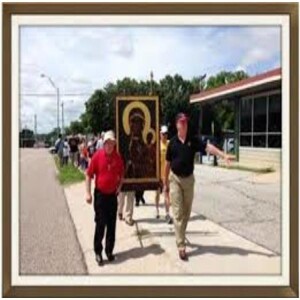Episodes

Wednesday Feb 14, 2024
Wednesday Feb 14, 2024
Stand In The Gap With Us T Saints Cyril and Methodius Ash Wednesday 2/14/2024
Cyril and Methodius must have often wondered, as we do today, how God could bring spiritual meaning out of worldly concerns. Every mission they went on, every struggle they fought was a result of political battles, not spiritual, and yet the political battles are forgotten and their work lives on in the Slavic peoples and their literature.
Constantine and Methodius were familiar with the Slavic language. Methodius, the older of the two brothers, became an important civil official who would have needed to know Slavonic. He grew tired of worldly affairs and retired to a monastery. Constantine became a scholar and a professor known as "the Philosopher" in Constantinople.
In 860 Constantine and Methodius went as missionaries to what is today the Ukraine.
Arriving in 863 in Moravia, Constantine began translating the liturgy into Slavonic. In the East, it was a normal procedure to translate liturgy into the vernacular. As we know, in the West the custom was to use Greek and later Latin, until Vatican II. The German hierarchy, which had power over Moravia, used this difference to combat the brothers' influence. The German priests didn't like losing their control and knew that language has a great deal to do with independence.

Tuesday Feb 13, 2024
Tuesday Feb 13, 2024
Stand In The Gap With And Saint Giles Mary of Saint Joseph “Consoler of Naples.” 2/13/2024
St Giles Mary was born on 16 November 1729 at Taranto, Apulia, Italy and died on 7 February 1812 at Naples, Italy of natural causes while at prayer.
Giles’ given name was Francesco, born to very poor but pious parents in the town of Taranto, Italy, in 1729. While still quite young, Francesco learned the rope-making trade and was reportedly very good at it.
It served him and his family well when his father died in 1747, leaving Francesco, at age 18, as the sole support of his mother and siblings.
His father died in 1747 and this forced Pontillo to seek work to provide for his widowed mother and siblings. For a brief period of time he worked as a rope maker.
The lack of a personal education meant that he was unable to become a priest and served instead as a professed religious in the Order of Friars Minor in Naples.
He applied to enter the order on 27 February 1754 and made his solemn profession of vows on 28 February 1755
Though he took up his responsibilities willingly, Francesco also felt the call to religious life. By the time he turned 25, he was able to secure his family’s financial future and subsequently applied to the Discalced Friars Minor in Naples.
Though he wanted to become a priest, he lacked sufficient education and was received as a lay brother instead. For the next nearly six decades Francesco, now St. Giles Mary of St. Joseph, acted as the porter and gatekeeper at his monastery’s seminary.
It was in that position that he discovered his true vocation. As the brother who opened the door to everyone who rang the bell, Giles came into contact with some of the poorest and most wretched citizens of Naples – people who he had a special gift to help.

Tuesday Feb 13, 2024
Tuesday Feb 13, 2024
Would you be Wise? Part 2
The Evil Spirit in the World – Diabolical Activity and Power
Our second course is on the evil spirit and you will find, I think you have the same chart that I have on the second page of your notes: The Evil Spirit in the World: Diabolical activity and power.
The Devil Exists and can be Known
First, by way of introduction: the devil exists and can be known. I cannot tell you how widespread is disbelief in the evil spirit especially among those who are supposed to be teachers of the Faith in the Catholic Church. In other words, without dwelling on this because the subject is an ocean, our task in this course is not to prove the existence of the evil spirit. It is, rather, to describe both how the evil spirit operates and how we are to cope with his demonic activity. It is part of the Church’s infallible teaching that the devil exists.
The Devil Came Into Existence as the Result of Self-will
The teaching of Sacred Scripture: the devil appears at the dawn of created history. In fact that’s how the devil first came into existence. The devil came into existence when the angels created by God and put on probation. We don’t know how many but very many refused to submit to the God who created them. In other words, the devils came into existence as the result of self-will. Self-will created the devils and, unlike us, unlike us the devils who fell were not given the chance to repent which St. Ignatius makes a great deal of to remind us how grateful we should be for two things: That we are created as rational human beings; and that, unlike the fallen angels, we have been redeemed and can repent. We’re all sinners – thanks to God’s mercy. The Church’s teaching, Her Magisterium and Catholic spirituality
We better know how to cope with this evil spirit

Monday Feb 12, 2024
Monday Feb 12, 2024
Stand In The Gap With Us And Saint Apollonia 2/12/2024
A holy virgin, Apollonia, lived in Alexandria, Egypt, in the third century. Christians were being persecuted there during the reign of Emperor Philip. Apollonia had spent her whole life serving God. Now that she was growing old, she was not about to take time to rest.
She bravely risked her life to comfort suffering Christians in prison. "Remember that your trials will not last long," she would say. "But the joys of heaven will last forever."
It was just a matter of time until Apollonia, too, was captured. When the judge asked her name, she courageously said, "I am a Christian and I love and serve the true God." Angry people tortured Apollonia, trying to force her to give up her faith. First, all her teeth were smashed and then knocked out. Strangely enough, that is why people frequently pray to St. Apollonia when they have a toothache. But even this painful ordeal did not shake the woman's faith.
Apollonia was then told that if she did not deny Jesus, she would be thrown into a raging fire. The woman would not let her fear overcome her. She chose to die by fire rather than abandon her faith in Jesus. When the pagans saw how heroic she was, many were converted. Apollonia died around 249.
Rather than renouncing her faith, she is said to have willingly offered up her own teeth, as well as those of her fellow martyrs, as a sign of her devotion to Jesus Christ.
Men seized her and, by repeated blows, broke all of her teeth. Then they erected a pile of sticks outside the city and threatened to burn her alive if she refused to repeat impious words after them (either a blasphemy against Christ, or an invocation of the heathen gods). When she was given a little freedom, at her own request, she sprang quickly into the fire and was burned to death.

Monday Feb 12, 2024
Monday Feb 12, 2024
Stand In The Gap With Us As We Honor Our Lady of Lourdes 2/11/2024
On 11 February 1858, Soubirous went with her sister Toinette and neighbor Jeanne Abadie to collect some firewood. While taking off her shoes and stockings to wade through the water near the Grotto of Massabielle, she said she heard the sound of two gusts of wind (coups de vent) but the trees and bushes nearby did not move.
A wild rose in a natural niche in the grotto, however, did move.I came back towards the grotto and started taking off my stockings. I had hardly taken off the first stocking when I heard a sound like a gust of wind. Then I turned my head towards the meadow. I saw the trees quite still: I went on taking off my stockings. I heard the same sound again. As I raised my head to look at the grotto, I saw a lady dressed in white, wearing a white dress, a blue girdle and a yellow rose on each foot, the same color as the chain of her rosary; the beads of the rosary were white … From the niche, or rather the dark alcove behind it, came a dazzling light
Soubirous tried to make the sign of the cross but could not, as her hands were trembling. The lady smiled, and invited Soubirous to pray the rosary with her.
Today Lourdes has a population of around 15,000, but it is able to take in some 5,000,000 pilgrims and tourists every season. With about 270 hotels, Lourdes has the second greatest number of hotels per square kilometer in France after Paris.

Sunday Feb 11, 2024
Sunday Feb 11, 2024
Stand In The Gap With Us And Saint Scholastica 2/10/2024
Born in 480 of wealthy parents, Scholastica and Benedict were brought up together until he left central Italy for Rome to continue his studies.
The Scripture teaches that if you train a child in the way of righteousness, they would never depart from it. Today, this is challenged like never before. In America today about one in ten Americans are classified statistically as "fallen away" Catholics. Something seems to have gone wrong the past few decades, parents are not as a whole handing on the faith to their children.
Twins often share the same interests and ideas with an equal intensity. Therefore, it is no surprise that Scholastica and her twin brother, Benedict, established religious communities within a few miles from each other.
The attack on the family has had a profound impact on faith. When Mom and dad are living the faith together as a family bond, their children holds fast to the faith more than 90% of the time. When everything falls on Mom because dad is out of the picture, children holding on to the faith drastically is reduced to between 10 to 30%.
Our problem today does not seem to have been a problem for Anicius Eupropius and his wife, Claudia Abondantia Reguardati. They were wealthy nobles living in Italy (Nursia Unbria), yet would be the parents of two recognized Saints, St Benedict was the twin brother of St Scholastica.
St. Scholastica was from a very young age strong in her Catholic faith. She wanted to live a life much like Sts Agatha and Lucy as she heard the heroic tales of their faith. 480 A.D. was a time when most young girls, especially from wealthy homes, were literate, well learned, often given in marriage, could own properties, and even divorce. That was not St. Scholastica.

Friday Feb 09, 2024

Thursday Feb 08, 2024
Thursday Feb 08, 2024
Stand In The Gap With Us And Saint Josephine Bakhita 2/8/2024
Saint Josephine Margaret Bakhita was born around 1869 in the village of Olgossa in the Darfur region of Sudan. She was a member of the Daju people and her uncle was a tribal chief. Due to her family lineage, she grew up happy and relatively prosperous, saying that as a child, she did not know suffering.
February 1877, Josephine was kidnapped by Arab slave traders. Although she was just a child, she was forced to walk barefoot over 600 miles to a slave market in El Obeid. She was bought and sold at least twice during the grueling journey.
For the next 12 years she would be bought, sold and given away over a dozen times. She spent so much time in captivity that she forgot her original name.
Josephine Bakhita was born in 1869, in a small village in the Darfur region of Sudan. She was kidnapped while working in the fields with her family and subsequently sold into slavery. Her captors asked for her name but she was too terrified to remember so they named her “Bakhita,” which means “fortunate” in Arabic.
As a slave, her experiences varied from fair treatment to cruel. Her first owner, a wealthy Arab, gave her to his daughters as a maid. The assignment was easy until she offended her owner's son, possibly for the crime of breaking a vase. As punishment, she was beaten so severely she was incapacitated for a month. After that, she was sold.
One of her owners was a Turkish general who gave her to his wife and mother-in-law who both beat her daily.
She told about how the general's wife ordered her to be scarred. As her mistress watched, ready with a whip, another woman drew patterns on her skin with flour, then cut into her flesh with a blade. She rubbed the wounds with salt to make the scars permanent. She would suffer a total of 114 scars from this abuse.

Thursday Feb 08, 2024
Thursday Feb 08, 2024
Deepertruth: Stand In The Gap With Us And Saint Colette 2/7/2024
(13 January 1381 – 6 March 1447) was a Frenchabbess and the foundress of the Colettine Poor Clares, a reform branch of the Order of Saint Clare, better known as the Poor Clares.
St. Colette was born Nicole Boellet, in Corbie, France. Her father was a poor carpenter at the Benedictine Abbey of Corbie. Tradition tells us that her parents were without children, and after having prayed to St. Nicholas for help in having a child, their prayers were answered. Her mother Marguerite gave birth to a daughter, Nicole at the age of 60.
her parents had grown old without having children, before praying to Saint Nicholas for help in having a child. Their prayers were answered when, at the age of 60, Marguerite gave birth to a daughter.
The little girl took great pleasure in prayer, in compassion for the poor, and in rigorous mortification, making of her soul and of her tender body a sacrifice to God. Up to her 14th year St Colette de Corbie remained unusually small in stature; the was a great grief got her father. St Colette begged God to console her father in this matter, and then she began to grow very rapidly to normal height.

Tuesday Feb 06, 2024
Tuesday Feb 06, 2024
Stand In The Gap With Us And St. Paul Miki and Companions 2/6/2024
Nagasaki, Japan, is familiar to Americans as the city on which the second atomic bomb was dropped, immediately killing over 37,000 people. Three and a half centuries before, 26 martyrs of Japan were crucified on a hill, now known as the Holy Mountain, overlooking Nagasaki.
Among them were priests, brothers, and laymen, Franciscans, Jesuits, and members of the Secular Franciscan Order; there were catechists, doctors, simple artisans, and servants, old men and innocent children—all united in a common faith and love for Jesus and his Church.
In the latter 1500's, Japan was mostly a Buddhist/Shinto nation when St. Francis Xavier (1506-1552) introduced the Catholic Faith in Japan near the middle-late 1540's. In a short period of time St. Francis converted over 200,000 converts despite the jealousy of the Buddhist priests who still maintained influence with the regional rulers.
In Japan, Jesus again finds Himself competing with another Emperor claiming to be a god. In 1587 the Japanese Emperor ordered the banishment of all Christian religious and a persecution of the Church soon followed. The Church went underground as the religious went into hiding. Over 3,000 Christians were martyred.
On December 8, 1596, Twenty-six Jesuits, Franciscans, and laypeople to include alter servers were captured, but these the Emperor wanted to make a warning to all the Japanese what would happen to any who would follow in their footsteps. Of the twenty-six condemned, there were three Japanese Jesuits, six Franciscans, seventeen Japanese laymen, four of which were 10, 13, 16, and 19 years old. After being tortured, they were forced to march over 1,000 miles from Miako to Hagasaki in the toughest of times. They traveled through snow and ice and freezing waters making it unbearable.
